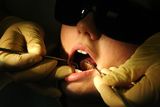Cameras capture womb with a view
WONDERS within the womb are revealed in a new Channel 4 programme following three animals from conception to birth.
WONDERS within the womb are revealed in a new Channel 4 programme that follows the extraordinary journey of three very different animals from conception to birth.
The two-hour documentary, to be broadcast over the Christmas holidays, uses hi-tech ultrasound scans and computer technology to show the development of an elephant, a dog and a dolphin in the womb.
Among the stunning moving images are an embryo golden retriever puppy panting, an eight-week dolphin foetus swimming inside its mother, and a perfect, miniature unborn elephant.
'Animals in the Womb' was made by the producers of 'Life Before Birth', the 2005 film that followed the development of a human foetus.
Fascinating
Jeremy Dear, who is the head of development at Pioneer Production which made the programme, said: "The film underlines some fascinating facts about our evolutionary heritage . . . and you can't help but be moved by each of our animal's journey towards birth.
"Via a combination of advanced technology, in-depth timeline of each foetus's development and birth, and state-of-the-art computer generated graphics, 'Animals in the Womb' offers a pretty extraordinary window on this previously unseen world."
Elephants undergo an epic 22-month pregnancy, with the foetus eventually tipping the scales at 120 kilograms. At about week 18, the unborn elephant stars exercising its legs and trunk to strengthen muscles and increase dexterity. It also grows ears and footpads that can detect sound.
The dolphin develops over the course of a year, generating the features it will need to help it swim as fast as 35 kilometres per hour and track prey the size of a ping-pong ball from 90 metres away.
At eight weeks, the dolphin foetus can be seen swimming in its own private pool, the womb.
The development of the dog is no less remarkable. In just 63 days, the dog foetus is armed with all the basic tools necessary to survive, including a highly acute sense of smell and the ability to detect sounds beyond the human range of hearing.
At 24 days, the dolphin embryo develops tiny, leg-like buds, which disappear over the next two weeks.
After 11 weeks, the embryo's fins display bone structures resembling human hands. Together, these two changes provide a startling echo of the dolphin's land-dwelling ancestors.
Conversely the world's largest land animal, the elephant, shows signs that its ancestors may have dwelled in the sea. The trunk is designed to act as a "snorkel" and allow the elephant to breathe underwater. Even stranger is the fact that elephant embryos develop kidney ducts usually found in freshwater fish.
Join the Irish Independent WhatsApp channel
Stay up to date with all the latest news














